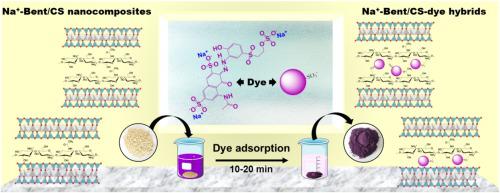当前位置:
X-MOL 学术
›
Colloids Surf. A Physicochem. Eng. Aspects
›
论文详情
Our official English website, www.x-mol.net, welcomes your
feedback! (Note: you will need to create a separate account there.)
What happens when chitosan meets bentonite under microwave-assisted conditions? Clay-based hybrid nanocomposites for dye adsorption
Colloids and Surfaces A: Physicochemical and Engineering Aspects ( IF 4.9 ) Pub Date : 2021-01-01 , DOI: 10.1016/j.colsurfa.2020.125584 Jefferson C.S. da Silva , D.B. França , Francisco Rodrigues , Dyego M. Oliveira , Pollyana Trigueiro , E.C. Silva Filho , M.G. Fonseca
Colloids and Surfaces A: Physicochemical and Engineering Aspects ( IF 4.9 ) Pub Date : 2021-01-01 , DOI: 10.1016/j.colsurfa.2020.125584 Jefferson C.S. da Silva , D.B. França , Francisco Rodrigues , Dyego M. Oliveira , Pollyana Trigueiro , E.C. Silva Filho , M.G. Fonseca

|
Abstract In this study, bionanocomposites were prepared with bentonite and chitosan in proportions of 50, 100, 200, and 300 % of the cation exchange capacity (CEC) of the bentonite using microwave heating at 50 °C for 15 and 30 min. The X-ray diffraction patterns indicated basal spacings in the range of 1.48–2.10 and 1.57–1.98 nm for nanocomposites obtained at 15 and 30 min of heating, respectively, suggesting the intercalation of chitosan in the interlayer space of montmorillonite. Fourier transform infrared spectra confirmed the incorporation of chitosan in bentonite. The results of the elemental analysis suggested a higher chitosan content for the nanocomposites prepared with 200 and 300 % of the CEC after 30 min of irradiation. Chitosan–bentonite nanocomposites obtained after 30 min of heating successfully adsorbed the Reactive Violet 5R dye from aqueous solutions. The influence of several factors such as the pH, adsorbent dosage, contact time, and initial dye concentration was investigated. The optimal adsorption conditions were a pH of 1.0 and a contact time of 20 min. The adsorption capacity reached 98.00, 207.71, 250.00, and 282.01 mg g−1 for nanocomposites prepared with 50, 100, 200, and 300 % of the CEC, respectively. In was demonstrated that the prepared bentonite–chitosan nanocomposites were good dye adsorbents.
中文翻译:

在微波辅助条件下,壳聚糖遇上膨润土会发生什么?用于染料吸附的粘土基杂化纳米复合材料
摘要 在本研究中,使用膨润土和壳聚糖的比例分别为膨润土阳离子交换容量 (CEC) 的 50%、100%、200% 和 300%,在 50°C 下微波加热 15 和 30 分钟,制备了生物纳米复合材料。X 射线衍射图表明,分别在加热 15 和 30 分钟时获得的纳米复合材料的基础间距在 1.48-2.10 和 1.57-1.98 nm 范围内,表明壳聚糖嵌入了蒙脱石的层间空间。傅里叶变换红外光谱证实了在膨润土中掺入了壳聚糖。元素分析的结果表明,在辐照 30 分钟后,用 200% 和 300% 的 CEC 制备的纳米复合材料具有更高的壳聚糖含量。加热 30 分钟后获得的壳聚糖-膨润土纳米复合材料成功地从水溶液中吸附了活性紫 5R 染料。研究了多种因素的影响,例如 pH 值、吸附剂用量、接触时间和初始染料浓度。最佳吸附条件是 pH 为 1.0,接触时间为 20 分钟。对于用 50%、100%、200% 和 300% CEC 制备的纳米复合材料,吸附容量分别达到 98.00、207.71、250.00 和 282.01 mg g-1。结果表明,制备的膨润土-壳聚糖纳米复合材料是良好的染料吸附剂。对于用 50%、100%、200% 和 300% CEC 制备的纳米复合材料,吸附容量分别达到 98.00、207.71、250.00 和 282.01 mg g-1。结果表明,制备的膨润土-壳聚糖纳米复合材料是良好的染料吸附剂。对于用 50%、100%、200% 和 300% CEC 制备的纳米复合材料,吸附容量分别达到 98.00、207.71、250.00 和 282.01 mg g-1。结果表明,制备的膨润土-壳聚糖纳米复合材料是良好的染料吸附剂。
更新日期:2021-01-01
中文翻译:

在微波辅助条件下,壳聚糖遇上膨润土会发生什么?用于染料吸附的粘土基杂化纳米复合材料
摘要 在本研究中,使用膨润土和壳聚糖的比例分别为膨润土阳离子交换容量 (CEC) 的 50%、100%、200% 和 300%,在 50°C 下微波加热 15 和 30 分钟,制备了生物纳米复合材料。X 射线衍射图表明,分别在加热 15 和 30 分钟时获得的纳米复合材料的基础间距在 1.48-2.10 和 1.57-1.98 nm 范围内,表明壳聚糖嵌入了蒙脱石的层间空间。傅里叶变换红外光谱证实了在膨润土中掺入了壳聚糖。元素分析的结果表明,在辐照 30 分钟后,用 200% 和 300% 的 CEC 制备的纳米复合材料具有更高的壳聚糖含量。加热 30 分钟后获得的壳聚糖-膨润土纳米复合材料成功地从水溶液中吸附了活性紫 5R 染料。研究了多种因素的影响,例如 pH 值、吸附剂用量、接触时间和初始染料浓度。最佳吸附条件是 pH 为 1.0,接触时间为 20 分钟。对于用 50%、100%、200% 和 300% CEC 制备的纳米复合材料,吸附容量分别达到 98.00、207.71、250.00 和 282.01 mg g-1。结果表明,制备的膨润土-壳聚糖纳米复合材料是良好的染料吸附剂。对于用 50%、100%、200% 和 300% CEC 制备的纳米复合材料,吸附容量分别达到 98.00、207.71、250.00 和 282.01 mg g-1。结果表明,制备的膨润土-壳聚糖纳米复合材料是良好的染料吸附剂。对于用 50%、100%、200% 和 300% CEC 制备的纳米复合材料,吸附容量分别达到 98.00、207.71、250.00 和 282.01 mg g-1。结果表明,制备的膨润土-壳聚糖纳米复合材料是良好的染料吸附剂。











































 京公网安备 11010802027423号
京公网安备 11010802027423号